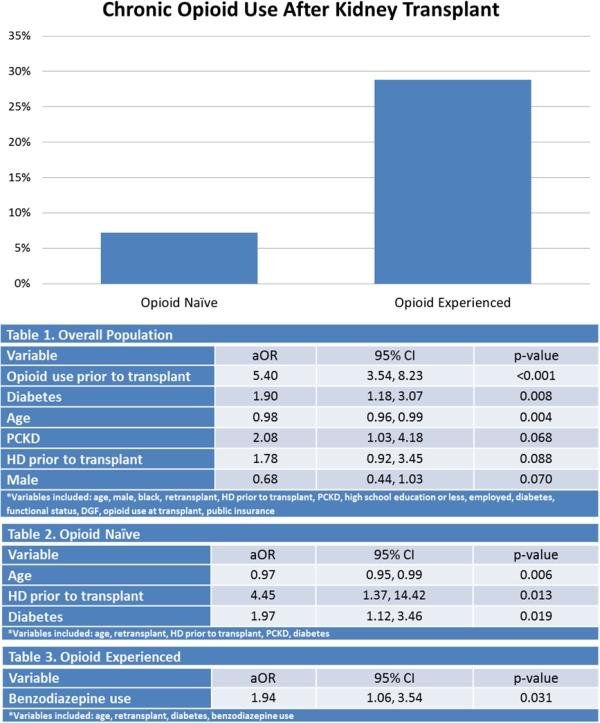Risk Factors for Chronic Opioid Use after Kidney Transplantation
J. Fleming, D. Taber, R. Gilbert, L. Wilson, Z. Elmaasarani, B. O'Brien, N. Patel, N. Pilch, S. Ball, P. Mauldin, P. Baliga.
MUSC, Charleston, SC.
Meeting: 2018 American Transplant Congress
Abstract number: 127
Keywords: Kidney transplantation, Psychosocial, Risk factors
Session Information
Session Name: Concurrent Session: Kidney Psychosocial - 1
Session Type: Concurrent Session
Date: Sunday, June 3, 2018
Session Time: 4:30pm-6:00pm
 Presentation Time: 5:06pm-5:18pm
Presentation Time: 5:06pm-5:18pm
Location: Room 210
Opioid use is associated with increased complications, graft loss, and mortality in the kidney transplant (KTX) population. The aim of our study was to identify risk factors for chronic opioid use in KTX.
METHODS: Single-center, retrospective cohort study of KTX between 1/10-12/16. Data was collected manual chart abstraction and use of a pharmaceutical claims database. Opioid experienced was defined as reported opioid use on medication reconciliation at the time of transplant or presence of an opioid prescription within 3 months prior to transplant via a national pharmaceutical claims database. Patients that filled an opioid prescription in 3 or more of the 11 months in the year after transplant (excluding the month of transplant) were identified as chronic opioid users (COU). Multivariable logistic regression with backward elimination was performed to identify risk factors for COU in the overall KTX population, as well as the opioid naïve and experienced sub-populations.
RESULTS: 1,129 KTX recipients were included in the analysis, 140 (12%) of whom were COU after transplant. Significantly more opioid experienced patients were COU after KTX compared to opioid naïve patients (78 (28.8%) vs 62 (7.2%), p<0.001) (Figure 1). In the overall KTX cohort, risk factors for COU included opioid use prior to transplant, DM and younger age (table 1). In the opioid naïve cohort, risk factors for COU included younger age, HD prior to transplant, and DM (table 2). In the opioid experienced population, the only independent risk factor for COU was benzodiazepine use at time of transplant (Table 3).
CONCLUSIONS: The strongest risk factor for COU after transplant is pre-transplant opioid use. Younger age, dialysis prior to transplant and diabetes are independent risk factors for COU in opioid naïve patients. Concomitant benzodiazepine is an independent risk factor for COU in opioid experienced patients.
CITATION INFORMATION: Fleming J., Taber D., Gilbert R., Wilson L., Elmaasarani Z., O'Brien B., Patel N., Pilch N., Ball S., Mauldin P., Baliga P. Risk Factors for Chronic Opioid Use after Kidney Transplantation Am J Transplant. 2017;17 (suppl 3).
To cite this abstract in AMA style:
Fleming J, Taber D, Gilbert R, Wilson L, Elmaasarani Z, O'Brien B, Patel N, Pilch N, Ball S, Mauldin P, Baliga P. Risk Factors for Chronic Opioid Use after Kidney Transplantation [abstract]. https://atcmeetingabstracts.com/abstract/risk-factors-for-chronic-opioid-use-after-kidney-transplantation/. Accessed December 31, 2025.« Back to 2018 American Transplant Congress

